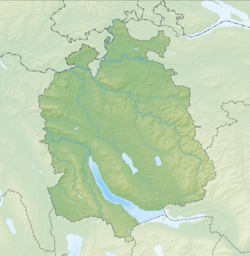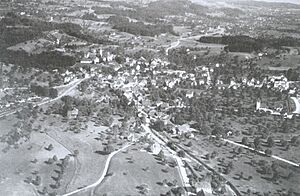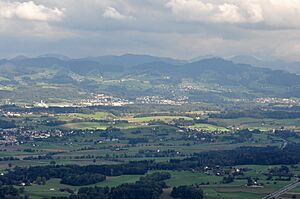Hinwil facts for kids
Quick facts for kids
Hinwil
|
||
|---|---|---|
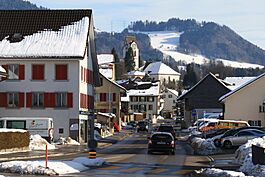 |
||
|
||
| Country | Switzerland | |
| Canton | Zurich | |
| District | Hinwil | |
| Area | ||
| • Total | 22.28 km2 (8.60 sq mi) | |
| Elevation | 565 m (1,854 ft) | |
| Population
(Dec 2020 )
|
||
| • Total | 11,354 | |
| • Density | 509.61/km2 (1,319.9/sq mi) | |
| Postal code |
8340
|
|
| Localities | Girenbad, Hadlikon, Ringwil, Unterbach, Unterholz, Wernetshausen, Bossikon, Erlosen | |
| Surrounded by | Bäretswil, Bubikon, Dürnten, Fischenthal, Gossau, Wald, Wetzikon | |
| Twin towns | Jablonné nad Orlicí (Czech Republic) | |
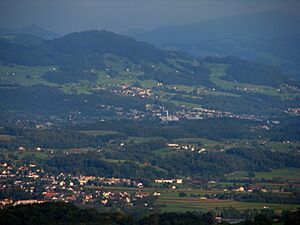
Hinwil is a municipality, which is like a town or district, located in the Canton of Zürich in Switzerland. It's part of the Hinwil district and is known for its beautiful surroundings.
Contents
History of Hinwil
The village of Hinwil was first mentioned way back in the year 745. It was called Hunichinwilari then. This name appeared in a document about a gift made to the Abbey of Saint Gall.
Other nearby villages, like Hadlikon (mentioned in 775) and Bossikon (mentioned in 829), were also given to the same abbey. Ringwil, with its church, was mentioned in 837, and Wernetshausen in 867. These villages were part of an Alamannic settlement. The Alamanni were a group of Germanic people.
Before the Alamanni, the Romans lived here! We know this because old Roman house foundations from the 1st century CE were found under Hinwil's medieval church. This church was first mentioned in the late 700s.
During the Middle Ages, Hinwil was part of a region called Grüningen. After 1280, it came under the control of the Knights of St. John in Bubikon. Later, during the time of the Reformation, control of Hinwil was shared between Zürich and the Knights.
How Hinwil Grew
Hinwil's economy first relied on farming and local crafts. In the late 1500s, people started making linen. By the 1600s, raising livestock and making cloth at home became very important.
When the railroad arrived in 1876, it brought more visitors and helped the town's economy. This led to a good period of growth before World War I.
Industrial production was not a big part of Hinwil's early history. However, it grew with companies like Bührer Traktorenwerke AG, which started making tractors in 1939. Another important company, Ferag AG, began in 1957, focusing on systems for handling materials, especially for newspaper production.
Geography and Nature
Hinwil covers an area of about 22.3 square kilometers (about 8.6 square miles). A large part of this land, 53.9%, is used for farming. Forests cover 26.8% of the area.
About 17.6% of the land has buildings or roads. The remaining small part (1.7%) includes rivers and other natural areas. In 1996, houses and buildings made up 11.5% of the total area. Roads and other transport areas made up 6.1%.
Hinwil is located in the Zürcher Oberland region, near the Bachtel mountain. The municipality was formed in 1798. It includes four main villages: Hinwil, Ringwil, Wernetshausen, and Hadlikon. Smaller areas like Bossikon, Erlosen, and Girenbad, along with many farms, also belong to the municipality.
People and Community
Hinwil has a population of around 11,000 people. About 13.7% of the people living here are from other countries. The population has grown by about 9.5% in the last ten years.
Most people in Hinwil speak German (91.1%). Italian is the second most common language (2.4%), followed by Albanian (1.1%).
Education and Jobs
Hinwil's population is well-educated. About 78.5% of adults (aged 25-64) have finished high school or gone on to higher education, like university. There are about 3,815 households in Hinwil.
The unemployment rate in Hinwil is low, at 1.94%. Many people work in different areas:
- Farming: 187 people work in farming, with about 77 businesses.
- Industry: 2,627 people work in manufacturing and industry, with 144 businesses.
- Services: 3,006 people work in service jobs (like shops, offices, healthcare), with 399 businesses.
In 2007, about 39.4% of working people had full-time jobs, and 60.6% worked part-time.
Religious Beliefs
In 2008, there were 2,610 Catholics and 4,657 Protestants in Hinwil. According to the 2000 census:
- 54.1% were Protestant (50.5% Swiss Reformed Church, 3.6% other Protestant churches).
- 26.5% of the population were Catholic.
- About 4.9% belonged to other religions.
- 10.8% said they were atheist or agnostic (meaning they don't believe in God or are unsure).
Population Growth Over Time
Here's how Hinwil's population has grown through history:
| year | population |
|---|---|
| 1637 | 624 |
| 1794 | 2,112 |
| 1850 | 2,697 |
| 1900 | 2,864 |
| 1950 | 3,623 |
| 1980 | 7,554 |
| 2000 | 9,157 |
Transportation
Hinwil has its own train station, called Hinwil railway station. It's the last stop on the Zürich S-Bahn S14 line. You can get to Zürich Hauptbahnhof (Zurich's main train station) in about 40 minutes from Hinwil.
Weather in Hinwil
Hinwil usually has about 145.4 days of rain each year. On average, it gets about 1341 millimeters (about 52.8 inches) of rain. The wettest month is August, with an average of 170 millimeters (about 6.7 inches) of rain. During August, it rains for about 14 days on average.
Economy and Companies
Hinwil is home to some interesting companies. One of the most famous is the Stake F1 Team. This is where Sauber Motorsport AG builds the cars and parts needed to compete in the exciting Formula 1 racing series!
Other important companies based in Hinwil include FBB (FBB Frischbeton & Baustoff AG), Ferag, and Belimo.
Notable People from Hinwil
Many interesting people have lived in or come from Hinwil:
- Ueli Maurer (born 1950): A Swiss politician who was a member of the Swiss Federal Council, a very important government position. He lives in Hinwil.
- Bruno Zuppiger (1952–2016): A Swiss business consultant and politician who lived in Hinwil.
- Dany Brand (born 1996): A Swiss athlete who was born in Hinwil. He specializes in the 400 meters hurdles race.
- Peter Sauber (born 1943): The founder and former leader of the Sauber F1 racing team. He lived in Hinwil.
See also
 In Spanish: Hinwil para niños
In Spanish: Hinwil para niños




